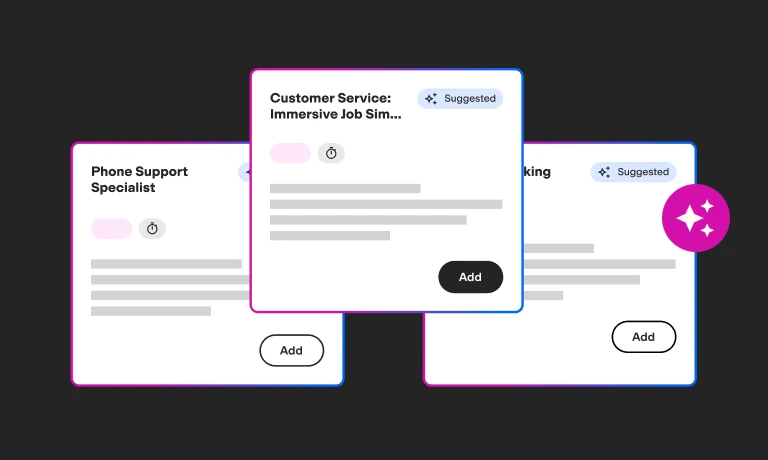6 ways to improve team synchronization
Through a combination of teamwork, coordination, and practice, synchronized swimmers are able to put on spectacular performances. Similarly, your company can achieve great success when everyone works together in harmony.
Conversely, when teams are out of sync, they often suffer missed deadlines, duplicated efforts, decreased productivity, and a chaotic approach to problem-solving – where problems might not get solved at all. This lack of harmony makes it extremely difficult to achieve business goals and can end up significantly impacting your bottom line – a risk you can’t afford to take in today’s highly competitive corporate world.
To create a truly high-performing team, you need to build an environment where employees work together seamlessly, understand each others’ actions intuitively, and engage in a shared culture.
In this article, we share six unique strategies that improve team synchronization to help you enhance performance across your organization and gain a vital competitive edge.
What is team synchronization?
Team synchronization refers to the alignment of team members’ efforts toward a common goal.
A synchronized team has:
Cohesion: There’s unity, camaraderie, and solidarity within the team.
Shared goals: Team members fully understand and are committed to achieving the same overarching objectives.
Complementary skills: Employees bring diverse skills and strengths that complement each other.
Exceptional communication: Individuals communicate effectively – verbally and non-verbally – and develop an intuitive understanding of each others’ styles and needs.
Adaptability: Teams adapt to changes swiftly, adjusting their strategies as needed.
Trust: Team members trust each others’ abilities, often giving their coworkers the freedom to make decisions without interference or micromanagement.
What team synchronization isn’t
Many don’t understand what team synchronization actually means, so their efforts to get their teams in sync fail.
We spoke to HR expert Yashna Wahal, who broke down some common misconceptions about team synchronization.
A synchronized team is one where everyone thinks and acts in the same way. ← This threatens diverse and innovative thinking.
To achieve team synchronization, employees should be recognized only at a team level. ← This completely ignores the importance and value of individual contributions.
The more employees communicate, the more in sync they are. ← While the frequency of communication is important, the quality of communication and understanding is what fosters true synchronization.
Employees must be close friends, with little to no boundaries, and work like a “family” to be synchronized. ← With team members that close, you can expect more biases in work and decision-making, increased conflicts, and a lack of accountability among team members, who will take each other for granted.
Team synchronization is a one-time achievement. ← You must make continuous efforts to keep your team in harmony with each other.
Why is team synchronization important?
Not convinced team synchronization is for you? Consider its many benefits.
1. Improved productivity and performance
A meta-analysis published in the Journal of Applied Psychology found that teams perform better when they’re more united or cohesive.
Ioana Andrei, HR expert and social entrepreneur, helps us understand why this may be the case.
“Keeping a team synchronized does more than simply ensure alignment on business goals and tasks. It creates a sense of shared responsibility and a ‘we’re all in this together’ attitude,” she explains. “This solidifies interpersonal bonds while increasing team productivity.”
2. Enhances cooperation at a neurological level
It makes sense that teams with deep understandings of each others’ communication and working styles are more cooperative and efficient in their efforts. But, what explains this?
A 2020 study from Frontiers in Human Neuroscience provides fascinating insights into how teamwork impacts brain function.
By comparing basketball players accustomed to teamwork with college students who typically work independently, the study found that the athletes completed tasks faster and exhibited higher levels of interpersonal neural synchronization. The study concluded that regular teamwork increases cooperation between team members at a cognitive level.
3. Fosters employee-being
Besides increasing individual and business performance, team synchronization is crucial to employee well-being, as highlighted by HR expert Medi Jones.
“People have a fundamental need to be liked and needed. It stems from our days as cavemen, where those ‘in the group’ would be protected, nurtured, and fed,” Jones explains.
“A modern explanation of this is Maslow’s hierarchy of needs. The third tier of Maslow’s pyramid speaks to the need to be loved and to belong. By enhancing team synchronization, organizations can address [...] higher-order needs – for example, esteem and self-actualization.”
4. Increases resilience
When team members have strong interpersonal relationships, shared goals, and a sense of psychological safety, they’re more likely to stay resilient and effectively get through periods of change or uncertainty.
Research from Tel Aviv University backs this up. A study found that top management team members who were open to learning from each other and growing together had higher levels of resilience and adaptability.
The best insights on HR and recruitment, delivered to your inbox.
Biweekly updates. No spam. Unsubscribe any time.
6 ways to improve team synchronization
Achieving team synchronization seems like a slow and effort-heavy process. But, with the right intent and strategies, you can achieve fast and long-lasting team harmony. Here’s what you should do.
Hire those who vibe with the tribe
Set WISE goals before SMART goals
Have a clear “north star”
Incorporate elements of a “total football” approach
Encourage diversity and build psychological safety
Use personalized coaching over team building
1. Hire those who vibe with the tribe
The simplest and fastest way to build a synchronized team is to hire smart. Recruit employees who bridge existing skills gaps, complement team members’ personalities, positively contribute to your company’s culture and working styles, and bring fresh ideas and diverse perspectives to the job.
Traditional methods like resume and cover letter screening don’t verify if candidates have the right skills, traits, and abilities to fit in with your existing employees.
Instead, opt for online testing. Here’s how it can help.
Talent assessments help ensure you’re hiring someone whose skill set complements the rest of the team.
Having candidates take personality and culture add tests enables you to assess their core characteristics and behaviors to see if they align with your team’s values.
Putting candidates through verbal and non-verbal communication skills testing can give you a solid idea of how effectively they can communicate.
Problem-solving, critical thinking, and other cognitive ability assessments are a great way to spot those who can bring unique perspectives and capabilities to your team.
Supplement these tests with structured interviews to dive deeper into each candidate’s suitability for a role. Ask for real-world examples and use follow-up questions to verify their responses.
Also, ask candidates probing questions about how they contribute in team settings and deal with conflict. This way, you can evaluate if they’ll mesh well with your team and company culture.
2. Set WISE goals before SMART goals
SMART goals – meaning specific, measurable, actionable, realistic, and time-bound goals – are the gold standard. However, they focus only on the “what” and the “how”. What makes a team truly synchronized is a sense of shared purpose – something higher that ties them together. This is the “why.”
In his popular TED Talk “How Great Leaders Inspire Action,” Simon Sinek explains that successful organizations and leaders help employees understand the purpose behind their goals and how their work contributes to those goals.
HR Expert Medi Jones also echoes this sentiment, saying, “Employees need to feel like what they do matters – not just to the managers or the shareholders but also to the organization’s mission and vision.”
Our suggestion? Before creating SMART targets, ensure that your team’s overarching goals are WISE. They should be:
Worthwhile: Add value and meaning to the company’s growth and employees’ professional development
Inspiring: Evoke a sense of motivation, enthusiasm, and passion so your team is fully driven to achieve them
Significant: Have a substantial impact on or importance to the company’s targets and objectives
Enduring: Align with the company’s long-term vision and core values – and remain aligned with them even through tough times
WISE goals instill an “us against the world” attitude, inspiring your team to work in sync and achieve their targets against all odds.
3. Have a clear “north star”
Daniel Pink, author of five New York Times bestsellers, shared his views on team synchronization with Fast Company. Pink’s research found that team synchronization works best when there’s a clear north star: a leader in command.
In most cases, this leader is a person. But, it could also be a deadline, a client, a benchmark, or a target.
Yashna Wahal, HR expert, explains that this north star must provide team members with a definitive and unwavering goal or purpose that guides decision-making and establishes a laser-like focus on a shared vision. She says, “Just as the north star guides sailors, a leader serves as a constant reference point, providing guidance and support even through uncertain or challenging times.”
Finally, a north star – regardless of its form – provides team members with positive feedback or a sense of fulfillment in having achieved their goal and reminds them of the role they play in the company’s mission.
Daniel Pink also touched on this final point. He termed this as “appealing to the heart” and suggested that feeling like an important member of the group and knowing how one makes a difference in the success of the group is a strong motivator and further encourages team synchronization.
4. Incorporate elements of a “total football” approach
A “total football” approach is a style of football where every player is equipped to play in every position on the field. Organizational change expert Karis Ferris also discusses the implications of this approach in a business setting. From a work perspective, this means each employee is trained to perform every role within their team.
Total Football may be feasible to incorporate in certain industries such as service or hospitality. It could also work in smaller companies or new startups where employees may need to wear different hats and switch gears often.
A total football approach can improve team synchronization by:
Giving employees a strong grasp of every role within their team. This strong understanding reduces the need for explicit communication and coordination and minimizes delays and redundancies.
Allowing team members to walk in each others’ shoes, fostering empathy and reducing conflict. For example, an employee who knows a job is time-consuming because they’ve done it themselves is likely to stay patient with a coworker assigned to that job.
Enabling the team to be flexible and adaptable during change. For instance, if an employee leaves, other team members can step in and prevent disruption till you backfill that role.
However, we believe that for most businesses, and especially in highly specialized jobs like healthcare or law, a total football approach is unrealistic and may even lead to inefficiencies.
We propose that companies adopt “cross-training” to reap the benefits of total football without implementing it in its entirety. Cross-training involves team members learning each others’ roles – at least to some extent.
You can achieve this through the below strategies:
Formal training: Put employees through formal classroom-style or online training to help them learn other roles within the company.
Job shadowing: Have employees shadow their peers occasionally to gain a deeper understanding of peers’ daily tasks, working styles, and more.
Rotating buddy system: Match employees with different “buddies” who can help them understand more about their own jobs.
Weekly theme days: Designate a day of the week with a particular theme (e.g., "Tech Tuesday" for sharing tech-related news) so employees can gain more insight into different departments.
5. Encourage diversity and build psychological safety
Complementary skills and diverse perspectives are key elements of a synchronized team.
In fact, Harvard Business Review shared a series of experiments where individuals in diverse teams were 58% more likely to price stocks correctly compared to non-diverse groups. Diverse teams tended to remain objective and encourage greater scrutiny of team members’ actions, keeping their joint cognitive resources sharp.
However, building diverse teams and encouraging varied perspectives isn’t enough.
An article published in Great Place to Work found that companies whose employees were uncomfortable sharing personal details – such as their sexual orientation or disabilities – had lower levels of employee trust, pride, and camaraderie at work. Such elements are critical to synchronized teams.
Another study investigated 117 undergraduate project teams. It found that while conflict arising as a result of diverse perspectives can improve team performance, this happens only when team members feel psychologically safe enough to share their opinions.
So, we believe it’s critical to build a diverse team and create an environment where employees feel safe to share their thoughts and ideas. Here are some ways to do this.
Post open roles to job boards that target certain demographics and minority groups. Consider eliminating information such as age, gender, and other diversity markers from applications to prevent biases during hiring.
Help employees understand each others’ differences through diversity and inclusion training and equip them with tools and techniques to combat unconscious biases.
Implement peer recognition programs where team members can recognize each other's efforts publicly. This boosts morale and fosters a sense of appreciation within the team.
Establish employee resource groups – volunteer-led groups focused on providing support and creating a sense of belonging for diverse groups.
Celebrate diverse holidays through events, newsletters, and social media.
Foster an environment where diverse opinions are encouraged, valued, and rewarded.
6. Use personalized coaching over team building
Sometimes, you can adopt all the right strategies and still struggle to achieve team synchronization. One of the first things companies do in this instance is to call on HR to put the team through team-building activities and games.
Our opinion? Team building activities can be fun and help employees build rapport – but they’re not the solution to a lack of synchronization. We agree with Forbes’ statement that team-building exercises can be “pointless” or even “insulting” because “they suggest that if only your team members spent more time doing silly things and solving group problems together… they would work more effectively together the rest of the time.”
HR expert Yashna Wahal says, “When a team isn’t meshing well, there are often underlying issues that must be resolved. Putting team members through games is hardly an effective way to do this, not to mention that many employees tend to feel annoyed and agitated by these forced activities.”
Instead, try to identify the root causes of poor team synchronization and offer personalized coaching to address these problems.
You could, for instance, use results from employees’ 360 feedback surveys (where you gather feedback on each employee’s performance from multiple sources). For example, if multiple workers claim to have communication issues with a particular employee, that employee may be contributing to the lack of team cohesion. In this case, offering communication skills training or coaching might help improve the situation.
Finally, you can also provide team-level coaching if there isn’t a specific employee at the core of the issue. Psychometrics – scientifically testing workers’ personality traits and cognitive abilities – is a great way to do this.
The 16-type personality test, for example, allows employees to better understand each others’ strengths and development areas, working preferences, and styles. This way, teams can appreciate their differences and work toward fostering alignment and harmony with their colleagues.
Maintaining team synchronization
Once you’ve built or improved team synchronization, you must actively maintain it. Here’s how.
1. Monitor team synchronization
While there isn’t one clear metric to measure team synchronization, some indicators can give you insight into how your teams are doing. We recommend examining team productivity levels, performance reviews, and manager or customer feedback forms regularly to spot emerging issues that could result from eroding team synchronization.
2. Communicate regularly
We agree with Ioana Andrei, HR expert and social entrepreneur, who suggests that you should “frame your team synchronization approach as an ongoing management strategy rather than a one-off event. Favor monthly all-hands meetings over yearly top-down communications – and weekly mentoring over yearly reviews.”
3. Reinforce the shared vision
You can’t expect employees to stay passionate about the company’s mission after a one-off speech at an annual town hall. Keep reminding employees of the organization’s goals. Discuss what purpose these goals serve and how employees’ work contributes to it.
Build a highly synchronized team with effective hiring and more
Team synchronization is the secret to the best-performing and most-innovative companies. Achieving an elite level of alignment often requires time and effort, but certain strategies can fast-track the process and provide your team with deep and long-lasting synchronization.
Hiring right with online testing and thoughtful interviews can give you the best shot at building a synchronized team. Additionally, establishing WISE goals, using a “north star,” adding elements of a total football approach, fostering diversity and psychological safety, and providing employees with tailored training and coaching can help cultivate a strong sense of understanding between team members.
Finally, team synchronization isn’t a one-time or quick fix. Monitoring team synchronization regularly, investing in ongoing communications, and reinforcing team members of their shared vision is the best way to build a solution with lasting success.
You've scrolled this far
Why not try TestGorilla for free, and see what happens when you put skills first.


















